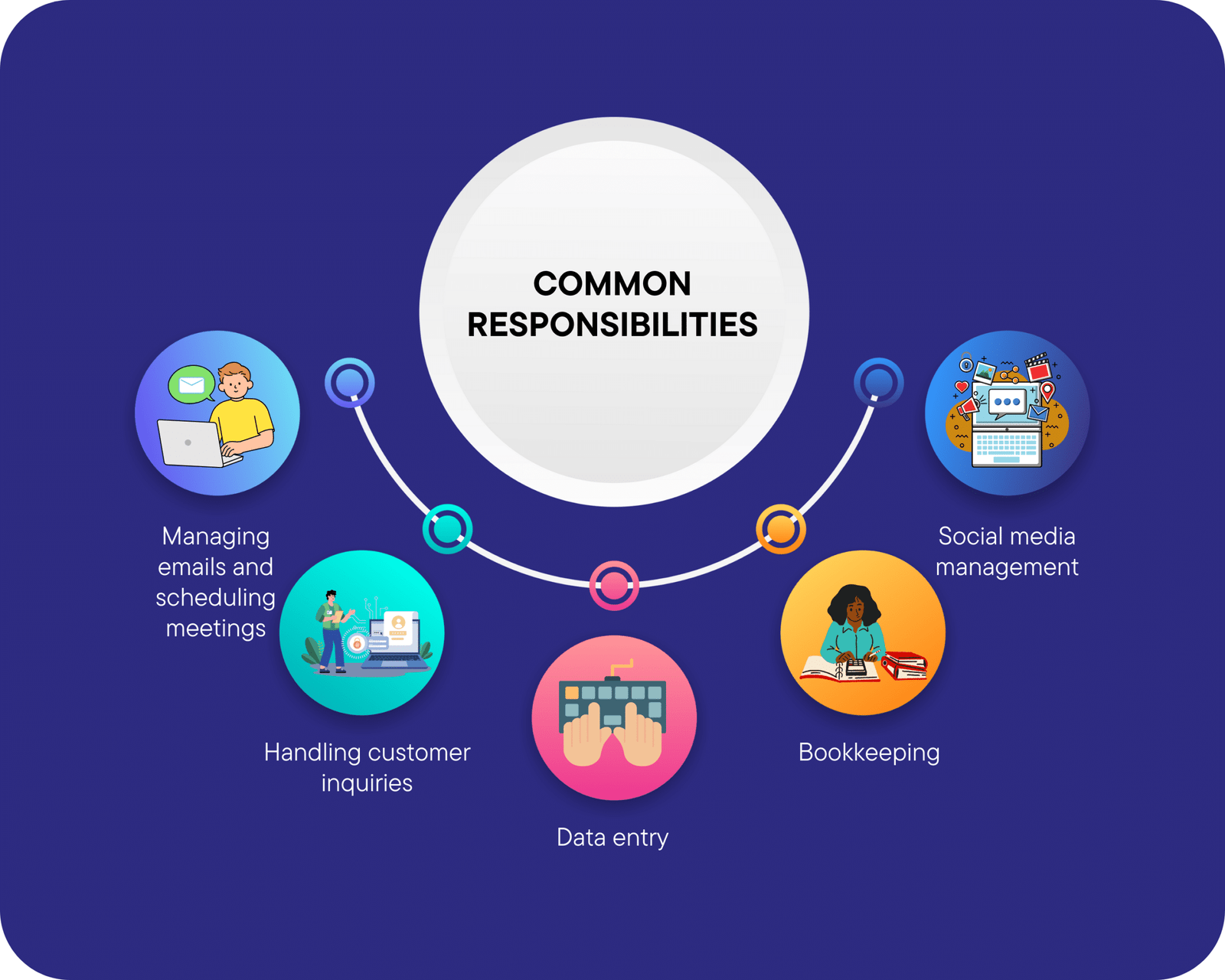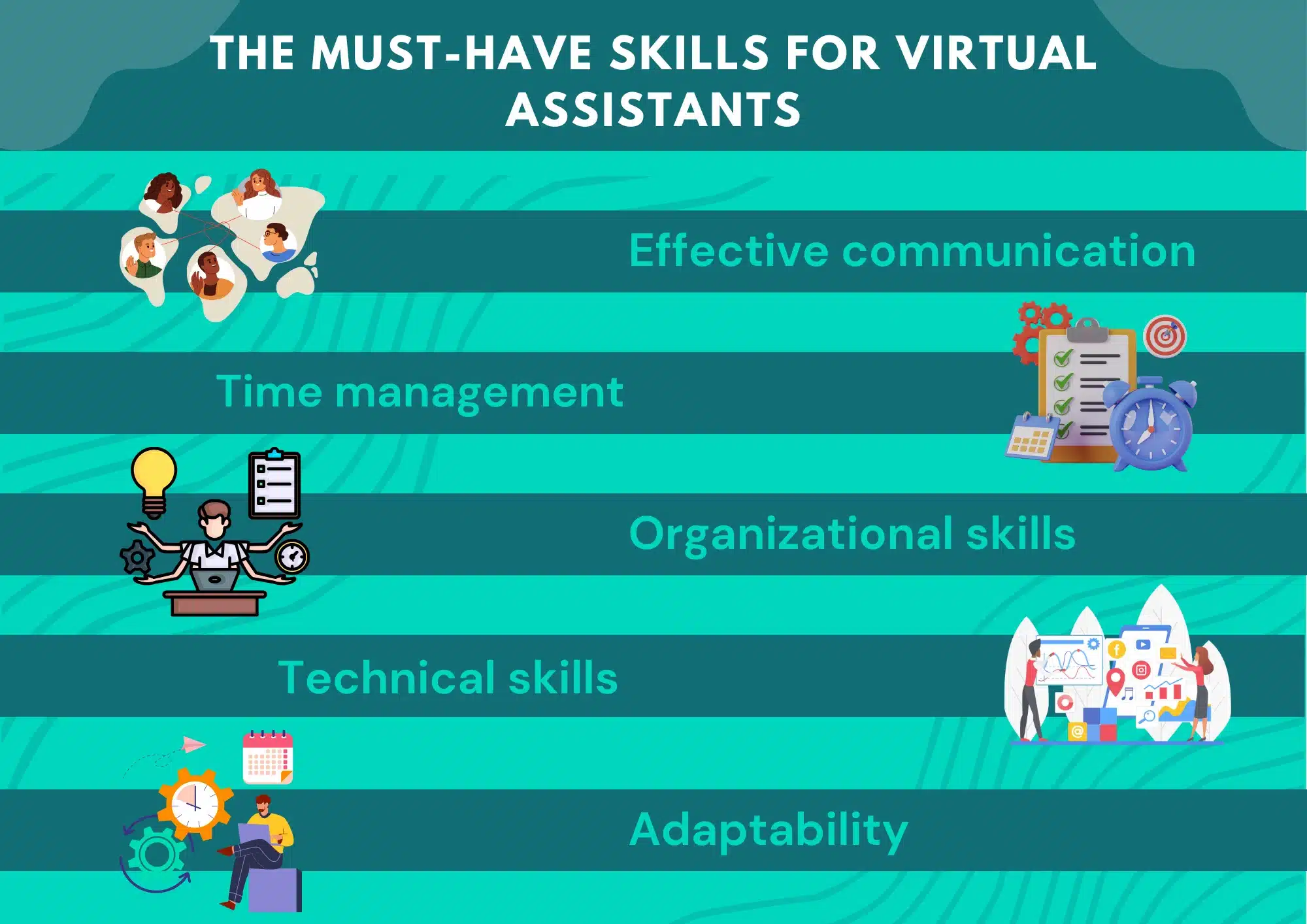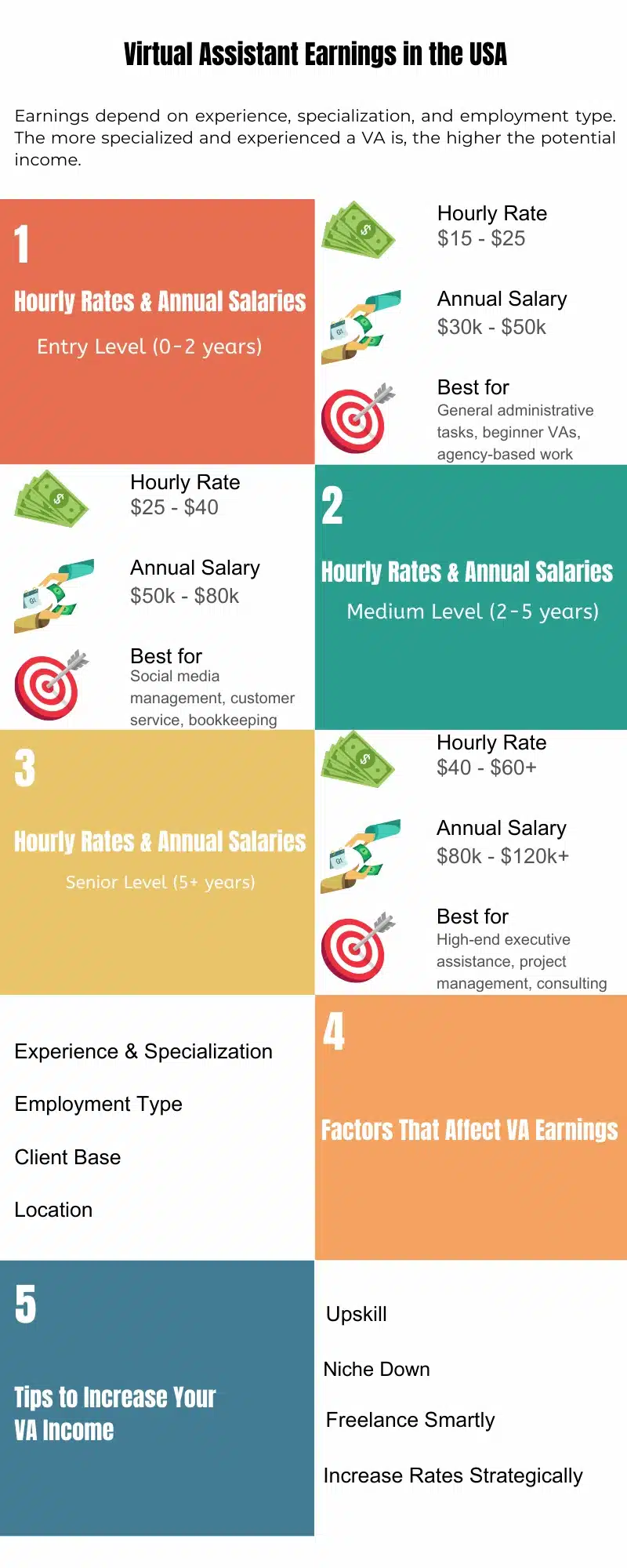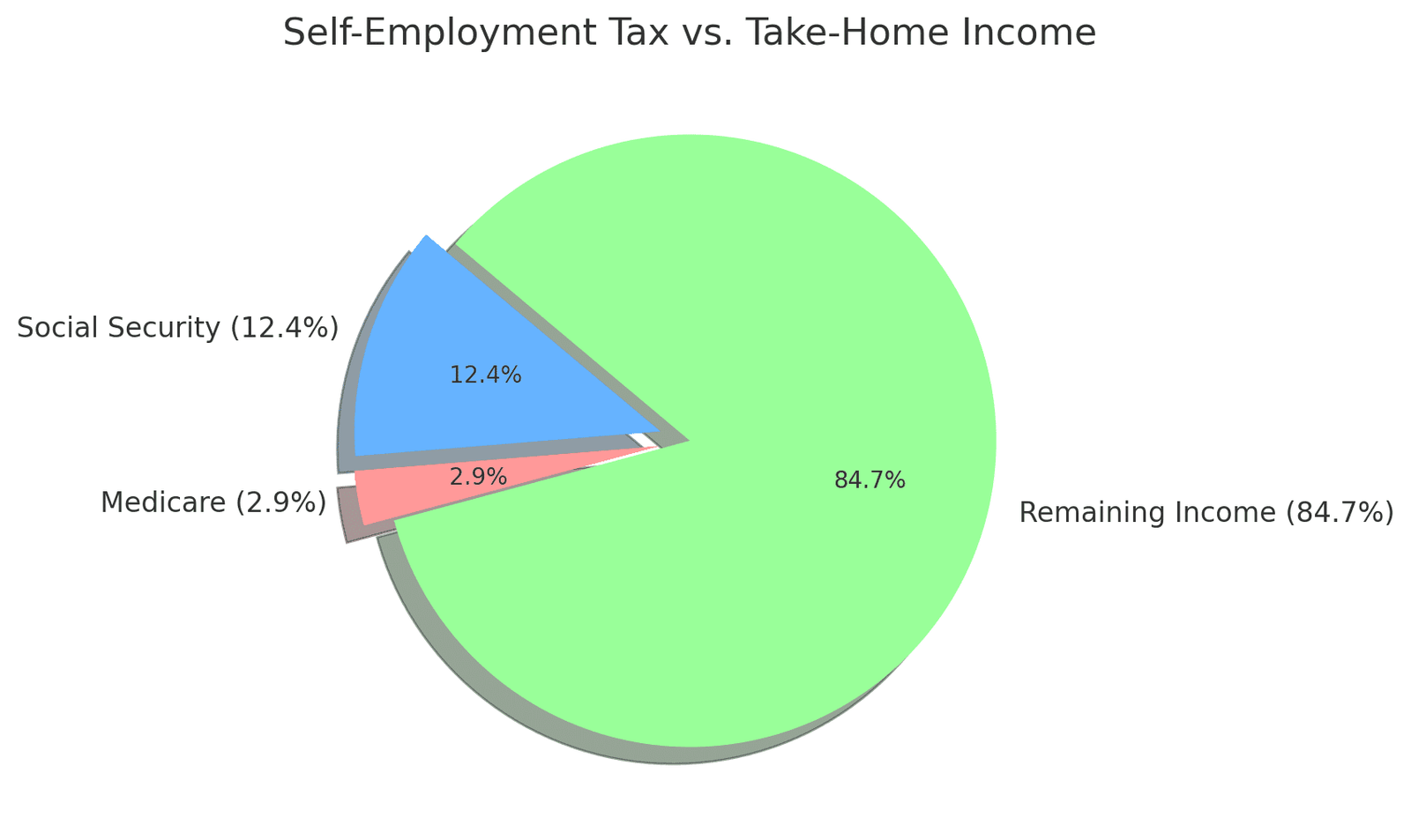Introduction
Do you want to become a virtual assistant but don’t know how? Maybe you’ve already looked into it, but you feel stuck and unsure about the first steps.
This article is specifically for you – those who want to start a career as a virtual assistant but aren’t sure how to find their first clients, what skills they need, or how to organize their work.
If you’re looking for a flexible job you can do from home but don’t know where to begin, keep reading – all the answers are right here.
The demand for virtual assistant jobs has surged as more companies adopt flexible work models. Employers are increasingly recognizing the value that VAs bring to the table. By hiring a virtual assistant, businesses can tap into a wealth of virtual assistant skills without the need for a physical office space. The appeal of becoming a virtual assistant stems from its accessibility. Individuals with diverse skill sets can enter this field, ranging from seasoned professionals to those looking to start a new career path.
The barriers to entry are relatively low, making it an attractive option for many. Additionally, the modern job market has shifted significantly; remote work opportunities have expanded, allowing VAs to collaborate with clients worldwide. This flexibility not only enhances work-life balance but also opens avenues for diverse projects and experiences.
As we look further into how to become a virtual assistant, it is important to understand the skills needed to succeed in this profession, the different niches available, and the potential for growth in the industry. The growing field of virtual assistance offers a great opportunity for those ready to pursue this career.
What Is a Virtual Assistant and What Do They Do?
A virtual assistant (VA) is a professional who provides remote administrative, organizational, and technical support to businesses and individuals. Instead of working from a traditional office, they operate online, assisting clients with various tasks that help keep daily operations running smoothly.

Some virtual assistants specialize in specific areas, such as marketing, project management, or content creation.
Virtual assistants work with a wide range of clients, from solo entrepreneurs and small businesses to large corporations. Strong communication, time management, and technical skills are key to excelling in this role. With the growing shift toward remote work, virtual assistants are becoming an essential part of modern business operations.
Want to find out more? Read What Is a Virtual Assistant? The Complete Guide for 2025 for details on VA roles, services, and business growth.
Build the Right Skills
To become a successful freelance virtual assistant, it’s important to evaluate and develop a strong set of skills that align with client needs across different industries. Effective communication is one of the key abilities required for this role. Since virtual assistants work remotely, they must be able to clearly convey information through email, chat, and video calls while also actively listening to client requests to ensure tasks are completed accurately.
Time management is another critical skill. Virtual assistants often handle multiple assignments at once, making it necessary to prioritize tasks and maintain an organized workflow. Using productivity tools such as Trello and Asana can help structure daily responsibilities, track deadlines, and ensure efficiency without compromising quality.
Beyond communication and time management, strong organizational skills are essential. Virtual assistants are responsible for managing files, maintaining records, and setting up streamlined systems for their clients. Familiarity with digital workspaces like Google Workspace and Microsoft Office is beneficial, as these tools facilitate collaboration and keep business operations running smoothly.
Technical skills also play a significant role in virtual assistance. Proficiency in software applications such as Slack for communication or CRM platforms for client management makes a virtual assistant a more valuable asset. Learning industry-specific tools, whether for e-commerce, marketing, or sales, can also improve job prospects and allow for specialization in certain fields.
Finally, adaptability is an important factor in succeeding as a virtual assistant. Client needs and business environments are constantly evolving, requiring assistants to stay updated on the latest tools, industry trends, and workflow methods. Developing a flexible mindset and continuously improving skills will help virtual assistants remain competitive and achieve long-term career success.

Gain Training and Certifications
Although a formal degree isn’t necessary to become a virtual assistant, additional training can improve your skill set and increase your chances of securing high-quality clients or job opportunities. Many online platforms offer courses in various areas that are highly relevant to virtual assistance.
Enrolling in these courses can help you develop expertise in specific tools and systems that businesses frequently use. For example, learning how to navigate project management software like Trello or Asana can make task coordination more efficient. If you’re interested in bookkeeping, becoming proficient in QuickBooks can be a major asset. Certifications in platforms like Salesforce, Google Workspace , or HubSpot can also boost your credibility and demonstrate your proficiency in handling specialized tasks.
Investing time in skill development can make you more competitive in the job market and allow you to offer a wider range of services. Whether you choose to take a single course or pursue multiple certifications, continuous learning will help you stay relevant and adaptable in the evolving virtual assistant industry.
Set Up a Professional Workspace
Since virtual assistants work remotely, having a dedicated and well-organized workspace is essential for maintaining focus and efficiency. A quiet environment free from distractions allows you to work professionally, whether managing emails, scheduling meetings, or handling customer inquiries.
Invest in a comfortable chair and ergonomic desk setup to prevent fatigue during long work hours. Reliable, high-speed internet is crucial, especially if you conduct video calls or manage cloud-based systems. A good-quality headset or noise-canceling headphones can enhance call clarity and minimize background noise.
If you handle frequent phone calls, consider setting up a virtual phone system or using a separate business line to maintain a professional presence. Organizing your digital workspace is just as important—use cloud storage, password managers, and task management tools to keep your work structured and secure.
Create a Portfolio
A well-crafted portfolio or personal website is one of the best ways to showcase your skills, experience, and past work. It acts as a visual resume that potential clients can review to understand your capabilities and professionalism.
If you are new to the field and lack real client samples, create mock projects that reflect the services you offer. For example, if you specialize in social media management, develop a sample content calendar or social media posts for an imaginary client. If you focus on administrative support, include examples of organized spreadsheets, email templates, or project management strategies.
Including testimonials from previous employers, colleagues, or clients can further strengthen your portfolio. If you have completed any relevant training or certifications, highlight them to demonstrate your expertise. The goal is to give clients a clear sense of what you can offer and why they should hire you.
Define Your Services and Pricing
Defining clear services and pricing is a crucial step in building a successful career as a virtual assistant. Before setting your rates, it’s important to precisely determine which services you offer and how you will charge for them.
How to Choose the Right Services?
- Focus on tasks you are already skilled at or can learn quickly.
- Consider market demand – What are the most in-demand VA services?
- Choose services that match your work style and interests.
VA service pricing varies based on several factors, including your experience, job complexity, and target market:
- Experience & Skills – Beginners typically charge lower rates, while experienced VAs can set premium prices.
- Type of Services – Technical services (e.g., graphic design, SEO, data analysis) tend to be higher-paying than basic administrative tasks.
- Geographic Factors – Clients from the USA and Western Europe usually pay more than those from lower-income regions.
- Urgency of Work – Rush jobs can be billed at a higher rate.
- Additional Services – Offering bundled service packages can increase overall revenue.

Note: These figures represent industry standards and may vary depending on the VA’s experience, the type of work, and the geographical market. It is always best to adjust pricing based on your services and client needs.
How to Charge for Virtual Assistant Services?
Choosing the right payment method and pricing strategy is essential for maintaining a professional and sustainable VA business. Below are different ways to receive payments from clients, along with essential tips for setting up a smooth billing process.
Payment Methods for Virtual Assistants
1. Invoicing Through Payment Platforms – Using secure payment processors ensures a smooth and professional transaction process. Popular invoicing platforms include:
- Stripe – Ideal for automated billing and subscription payments.
- PayPal – A widely accepted option for international clients.
- Wave – A free invoicing tool with built-in accounting features.
- FreshBooks – Designed for freelancers, offering invoicing and bookkeeping in one place.
2. Freelance Platforms with Built-in Payment Systems – If you’re working through Upwork, Fiverr, or Freelancer, these platforms handle payments on your behalf. However, they charge service fees that can range from 10% to 20% of your earnings. While convenient, keep these deductions in mind when setting your rates.
3. Direct Payments from Clients – For long-term clients, direct bank transfers or invoicing via QuickBooks can be a more cost-effective option. This approach eliminates transaction fees and offers more control over payment schedules.
Best Practices for Virtual Assistants When Charging Clients
- Set Competitive Rates – Research industry standards before pricing your services to ensure you are neither undercharging nor overpricing.
- Use Clear and Professional Invoices – Always include details such as the project scope, hourly rate, payment terms, and due dates.
- Offer Flexible Payment Options – Some clients prefer milestone payments or monthly retainers, while others may opt for one-time project fees.
- Consider a Trial Period – Offering a discounted first month can help attract new clients and establish long-term collaborations.
- Adjust Your Pricing Over Time – As you gain experience and expertise, review and update your rates to reflect your skills and market demand.
Setting up a structured payment system not only enhances your professionalism but also ensures financial stability as a virtual assistant.
Network and Promote Your Services
Networking plays a key role in growing your virtual assistant business. Inform your existing network—including friends, family, and former colleagues – about your services. Word-of-mouth recommendations can lead to new opportunities, especially if you maintain a strong professional reputation.
Attending virtual and in-person networking events can introduce you to business owners, entrepreneurs, and potential clients. Consider joining professional associations, such as virtual assistant groups or industry-specific networks, to expand your reach.
Social media marketing is another way to promote your services. Regularly sharing tips, success stories, and client testimonials can help establish your expertise. You can also collaborate with other freelancers or business owners, offering complementary services that can lead to mutual referrals.
Search for Clients and Jobs
Finding work as a virtual assistant requires a proactive approach. There are several ways to connect with potential clients, including:
- Freelance Platforms: Freelance platforms provide opportunities for virtual assistants to connect with clients looking for remote support.
- Job Boards: Look for remote job listings on platforms.
- Direct Outreach: Identify companies or entrepreneurs who could benefit from your services and send personalized pitches explaining how you can assist them.
- Social Media and Networking Groups: Many business owners seek virtual assistants through Facebook groups, LinkedIn job postings, and online communities.
When applying for jobs or reaching out to potential clients, ensure your proposals are clear, professional, and specifically aligned with the needs of each client. Avoid scams by researching companies before committing to any projects or contracts.
To avoid potential scams when choosing platforms and clients, it’s important to stay informed. You can read more in How to Protect Your Business from Virtual Assistant Scams.
Aspiring freelance virtual assistants have a variety of platforms at their disposal when searching for job opportunities. Over the past few years, the demand for virtual assistants has increased, creating numerous openings across different industries. Whether you are looking for part-time, full-time, or project-based roles, multiple online platforms and specialized services can help you connect with potential clients.
If you want to learn more about each platform, visit their official websites:
- Upwork
- Fiverr
- Wishup
- Freelancer
- PeoplePerHour
- Belay Solutions
- Time Etc
- Zirtual
- LinkedIn Jobs
- Virtual Vocations
- Fancy Hands
- Boldly
- FreeUp
- We Work Remotely
Virtual assistants can work independently or through established companies that connect them with clients. Check out The Best Virtual Assistant Companies.
Prepare for Interviews
Many virtual assistant roles require an interview process to assess your skills, professionalism, and compatibility with the client’s needs. To make a strong impression, prepare by:
- Practicing responses to common interview questions, such as how you handle deadlines, prioritize tasks, or manage multiple clients.
- Showcasing your knowledge of relevant software and tools.
- Demonstrating clear and confident communication skills, especially if the role involves client interactions.
- Familiarizing yourself with video conferencing tools like Zoom, Microsoft Teams, or Google Meet to ensure a smooth interview experience.
The more prepared you are, the more confident and professional you will appear. Interviews are also an opportunity for you to evaluate the client and ensure their expectations align with your expertise and work style.
By following these steps, you can build a strong foundation for a successful career as a virtual assistant. Establishing a solid workspace, showcasing your skills, and networking effectively will increase your chances of securing long-term clients and growing your business.
The Hiring Process for Virtual Assistants
The hiring process for freelance virtual assistant positions typically begins with the preparation of applications that showcase the candidate’s relevant skills and experience. Aspiring virtual assistants should create resumes that emphasize their strengths in organization, communication, and technical skills. A well-structured portfolio with examples of past work or case studies can make an application more appealing, allowing potential employers to gauge a candidate’s abilities. Demonstrating proficiency in relevant tools and software further strengthens credibility and increases the chances of securing opportunities.
Once applications are submitted, candidates often proceed to the interview stage. Employers may ask a variety of common interview questions designed to gauge both technical skills and cultural fit. Questions may include scenarios relating to time management, workload balancing, and problem-solving approaches. Additionally, evaluators will look for a strong understanding of the specific requirements tied to various virtual assistant jobs, ensuring that candidates possess the necessary expertise to thrive in the role.
Many firms will also implement test projects as a crucial component of the hiring process. These projects serve as practical assessments that allow candidates to demonstrate their ability to execute tasks effectively and showcase their mastery of vital virtual assistant skills. Successfully completing a test project can significantly influence hiring decisions, as it provides tangible evidence of a candidate’s abilities in a real-world context.
Following the successful selection of a candidate, the onboarding process begins. This stage involves familiarizing the new virtual assistant with the tools and systems they will be using, establishing communication channels, and defining reporting structures. It is essential for both employers and virtual assistants to understand these processes, as they set the foundation for efficient collaboration. Overall, a structured hiring approach ensures that the best candidates are matched with roles that align with their skills and experience, contributing positively to the success of the organization.
Taxes and Legal Considerations
As a freelance virtual assistant in the United States, it’s important to understand your tax obligations and legal responsibilities. Operating as a self-employed individual means you’re responsible for both income tax and self-employment tax, which covers Social Security and Medicare contributions.
Self-Employment Tax Rate
The self-employment tax rate is 15.3%, comprising 12.4% for Social Security and 2.9% for Medicare. For 2025, the first $176,100 of your net earnings is subject to the Social Security portion of this tax.

Quarterly Estimated Tax Payments
Unlike traditional employees, self-employed individuals must make quarterly estimated tax payments to cover both income and self-employment taxes. These payments are due on April 15, June 15, September 15, and January 15 of the following year. Failing to make timely payments can result in penalties.
Deductible Business Expenses
Keeping accurate records of your business expenses can significantly reduce your taxable income. Common deductible expenses include office supplies, software subscriptions, and a portion of your home office costs if you work from home. Maintaining proper documentation and receipts is essential, especially in the event of an IRS audit.
Legal Considerations
Operating as a self-employed individual may require you to register your business, obtain necessary licenses, and comply with local regulations. Consulting with a tax professional or accountant who specializes in self-employment can help you navigate these requirements effectively.
By staying informed about your tax obligations and maintaining thorough records, you can manage your financial responsibilities as a virtual assistant more effectively.
For more details, visit the official IRS website.
Challenges and Tips for Success
Embarking on a career as a freelance virtual assistant can be rewarding; however, it also presents a unique set of challenges. One of the primary difficulties faced by virtual assistants is managing multiple clients efficiently. Juggling various tasks and deadlines for different clients can lead to confusion and potential burnout. To counteract this, effective time management becomes an essential skill. Implementing tools such as calendar apps or project management software can help streamline tasks and ensure that deadlines are met without overwhelming oneself.
Another common challenge is the variability of income. Unlike traditional employment, virtual assistant jobs often come with fluctuating workloads. This unpredictability necessitates strategic financial planning. Establishing a buffer in savings can provide peace of mind during leaner periods. Additionally, diversifying skill sets can attract a broader range of clients, potentially leading to a more stable income stream.
Burnout is another significant concern, particularly for those who work from home. The blurring of boundaries between personal and professional life can make it difficult to disconnect. To address this issue, establishing a clear work-life balance is crucial. Setting specific work hours, creating a dedicated workspace, and scheduling regular breaks can enhance productivity while safeguarding mental well-being.
To maintain a competitive edge in the world of virtual assistant roles, staying updated with new tools and industry trends is vital. Continuous learning through online courses or workshops can improve virtual assistant skills and enhance service offerings. Engaging in online communities of virtual assistants can also provide valuable insights and support. Networking can lead to collaborative opportunities and referrals, which are beneficial for career growth. By acknowledging these challenges and implementing practical strategies, aspiring virtual assistants can pave the way for success in this dynamic field.
Conclusion
Becoming a virtual assistant is not an easy path, but it can be very profitable and with opportunities for advancement in your professional career. Whether you’re looking for full-time remote work or side income, this profession allows you to use your skills, work with clients around the world and create a schedule that fits your lifestyle.
By developing the right skills, building a strong online presence, and networking effectively, you can attract high-quality clients and establish a sustainable business.
The demand for virtual assistants continues to grow – now is the perfect time to get started! Take the first step by defining your services, creating a portfolio and reaching out to potential clients.
If you want to find out more about virtual assistants, their services, and how to grow in this field check out our latest blog posts


